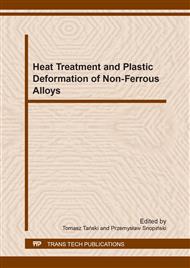p.41
p.53
p.66
p.81
p.89
p.100
p.113
p.124
p.134
The Influence of Severe Plastic Deformation Process on Structure and Properties of AZ 31 Alloy after Selected Heat Treatment
Abstract:
The technology of structure refinement in materials with the aim of achieving substantial mechanical properties and maintaining the required plasticity level is becoming increasingly useful in industrial practice. Magnesium alloys are very progressive materials for utilization in practice thanks to their high strength-to-weight ratios (tensile strength/density). The presented paper analyses the effect of the input heat treatment of the AZ31 alloy on the change of structure and strength properties through the process of severe plastic deformation (SPD), which finds an increasing utilization, especially in the automotive and aviation industry. For the study of the influence of the SPD process (ECAP method) on the properties of the AZ31 alloy, two types of thermal treatment of the initial state of the structure were selected. The analysis of the structure of the AZ31 alloy was performed in the initial state without heat treatment and subsequently after heat treatment. In the next part, the influence of the number of passes on the strengthening curves was evaluated. Mechanical properties of the AZ31 alloy after ECAP were evaluated by hardness measurement and completed by structure analysis.
Info:
Periodical:
Pages:
134-146
Citation:
Online since:
June 2018
Keywords:
Price:
Сopyright:
© 2018 Trans Tech Publications Ltd. All Rights Reserved
Share:
Citation:


